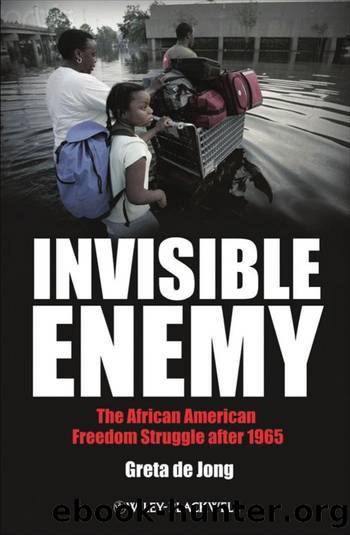Invisible Enemy: The African American Freedom Struggle After 1965 by Greta de Jong

Author:Greta de Jong [Jong, Greta de]
Language: eng
Format: mobi, epub, azw3
Tags: United States, 20th Century, General, History
ISBN: 9781405167178
Publisher: Wiley-Blackwell
Published: 2010-01-28T06:25:38.881865+00:00
is this america?
125
leaders. Even as the landmark voting rights legislation empowered African Americans, the struggle to fulfi ll its promise revealed weaknesses in the nation â s democracy that raised the question again: Is this America?
Black Political Empowerment and White Resistance The Voting Rights Act outlawed the literacy tests and other practices southern states had used to prevent African Americans from voting and allowed for federal registrars to be sent to counties where few black people had been able to register in the past. To prevent racist lawmakers from devising new ways of disfranchising black voters, Section 5 of the act required states and political subdivisions that had a history of discrimination to submit any proposed new election procedures for approval by the Justice Department.
The legislation â s impact on voter registration rates for black southerners was immediate and dramatic. In Mississippi, the proportion of eligible black voters who were registered increased from 5 percent in 1960 to 61 percent in 1976. Over the same period the number of African Americans registered to vote in all 11 southern states grew from 1.5 million to 4 million. 3
Civil rights activists knew that massive black voter registration alone could not topple the segregationist social order in the South. Black southerners needed to learn the mechanics of the electoral system to secure political power and gain a voice in the decisions that affected their lives. In 1966
SEDFRE initiated a leadership development program designed to teach African Americans how to use the democratic tools made available by the Voting Rights Act to maximum effect. Local activists attended SEDFRE
workshops to learn how to build political organizations, run candidates for offi ce, and win elections. Prospective candidates received instruction on every aspect of the process, from printing campaign leafl ets to getting out the vote and monitoring polling places on election day. SEDFRE also worked to develop â citizen leaders â among those who were not interested in running for offi ce but stood ready to pressure local offi cials to respond to their concerns. This approach was in keeping with the philosophy of grassroots organizing that infl uenced SNCC and CORE
â s work among
black southerners in the early 1960s. As veterans of those earlier efforts, SEDFRE activists knew that real social change came from the bottom up rather than through the actions of a few charismatic leaders or elected offi cials. Leadership development workshops empowered ordinary people to infl uence political decisions by showing them how government worked and encouraging regular communication (through protests, if necessary) with their representatives.
In the late 1960s and early 1970s SEDFRE trained thousands of local activists in hundreds of communities across the nation. As African Americans
126
is this america?
were elected to public offi ce SEDFRE followed up its leadership development initiatives with programs to assist newly elected black offi cials.
Executive director Marvin Rich explained, â We helped to get some of these people elected simply by showing them methods of campaigning. Now they want help in functioning more effectively in their new responsibilities.
Download
Invisible Enemy: The African American Freedom Struggle After 1965 by Greta de Jong.epub
Invisible Enemy: The African American Freedom Struggle After 1965 by Greta de Jong.azw3
This site does not store any files on its server. We only index and link to content provided by other sites. Please contact the content providers to delete copyright contents if any and email us, we'll remove relevant links or contents immediately.
The Secret History by Donna Tartt(16674)
The Social Justice Warrior Handbook by Lisa De Pasquale(11495)
Thirteen Reasons Why by Jay Asher(7806)
This Is How You Lose Her by Junot Diaz(5802)
Weapons of Math Destruction by Cathy O'Neil(5050)
Zero to One by Peter Thiel(4839)
The Myth of the Strong Leader by Archie Brown(4796)
Promise Me, Dad by Joe Biden(4459)
Beartown by Fredrik Backman(4437)
Stone's Rules by Roger Stone(4426)
How Democracies Die by Steven Levitsky & Daniel Ziblatt(4423)
The Fire Next Time by James Baldwin(4353)
100 Deadly Skills by Clint Emerson(4089)
A Higher Loyalty: Truth, Lies, and Leadership by James Comey(4043)
Rise and Kill First by Ronen Bergman(4026)
The David Icke Guide to the Global Conspiracy (and how to end it) by David Icke(3899)
The Farm by Tom Rob Smith(3881)
Secrecy World by Jake Bernstein(3791)
The Doomsday Machine by Daniel Ellsberg(3742)
